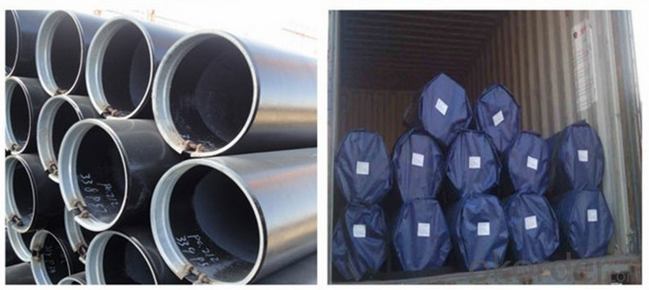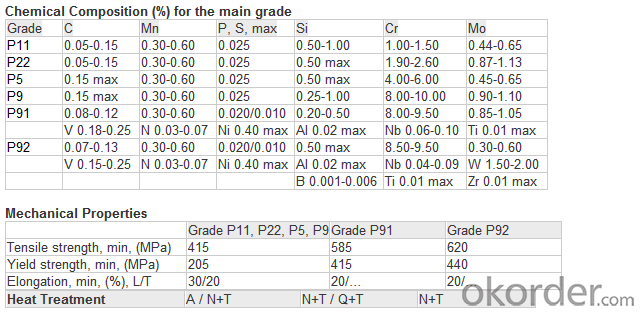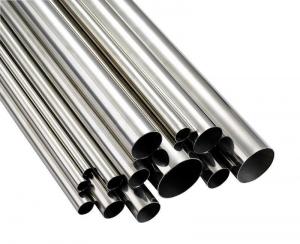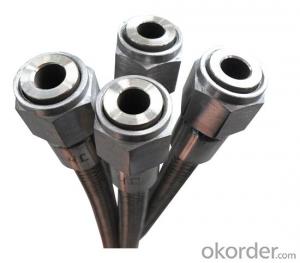Seamless Ferritic Alloy-Steel Pipe for High-Temperature Service in 2015
- Loading Port:
- Shanghai
- Payment Terms:
- TT OR LC
- Min Order Qty:
- 5000 kg
- Supply Capability:
- 10000 kg/month
OKorder Service Pledge
OKorder Financial Service
You Might Also Like
Description:
(1) nominal wall and minimum wall seamless ferritic alloy-steel pipe intended for high-temperature service. Pipe ordered to this specification shall be suitable for bending, flanging (vanstoning), and similar forming operations, and for fusion welding.
(2)Each length of pipe is subjected to the hydrostatic test and examined by a non-destructive examination method in accordance to the required practices. The range of pipe sizes that may be examined by each method is subjected to the limitations in the scope of the respective practices. The different mechanical test requirements for pipes has been passed.
(3)Ferritic steels are defined as low- and intermediate-alloy steels containing up to and including 10 % chromium.
ASTM A335 Seamless Alloy-Steel Pipe
Standard: BS 1139, BS 3059-2, JIS G3454-2007
Grade: 10#-45#, 15NiCuMoNb5, 10Cr9Mo1VNb
Detailed introduction to ASTM A335 seamless alloy steel pipe:
ASTM A335 seamless alloy steel pipe

Packaging Detail: | Bundle or Container or as per customers requirement. |
Delivery Detail: | within 25 days after we receive an irrevocable L/Cor 30% deposit |
ASTM A335 Seamless Alloy-Steel Pipe
Standard: BS 1139, BS 3059-2, JIS G3454-2007
Grade: 10#-45#, 15NiCuMoNb5, 10Cr9Mo1VNb
Detailed introduction to ASTM A335 seamless alloy steel pipe:
ASTM A335 seamless alloy steel pipe


FAQ:
1) why you chose us ?
Professional Manufacturer and supplier of Steel pipe
More than 14 years’ professional producing experience
We can get the lowest ex-factory prices. The price are quite reasonable and it is lower than our commercial peers. also, we can guarantee the qualities of our products.
BV, ISO certificates and SGS test can be provided to assure the quality of our products.
2) Our minimum order quantity:
10 Metric Tons or one 20ft or 40ft Container.
3) How about the Delivery Time?
The steel pipe will be produced since we getting your deposit by T/T or Your original L/C. For normal size, some stocks in our factory now, we can supply once you need.
4)What kind of payment does your company support?
T/T, 100% L/C at sight, Cash, Western Union are all accepted.
5) Do you charge for the samples?
According to our company principle, we just charge for samples, you pay for the freight /courier charge.
6) Main market:
Mid East, South America, Africa, Southeast Asia, India etc
FAQ:
1) why you chose us ?
Professional Manufacturer and supplier of Steel pipe
More than 14 years’ professional producing experience
We can get the lowest ex-factory prices. The price are quite reasonable and it is lower than our commercial peers. also, we can guarantee the qualities of our products.
BV, ISO certificates and SGS test can be provided to assure the quality of our products.
2) Our minimum order quantity:
10 Metric Tons or one 20ft or 40ft Container.
3) How about the Delivery Time?
The steel pipe will be produced since we getting your deposit by T/T or Your original L/C. For normal size, some stocks in our factory now, we can supply once you need.
4)What kind of payment does your company support?
T/T, 100% L/C at sight, Cash, Western Union are all accepted.
5) Do you charge for the samples?
According to our company principle, we just charge for samples, you pay for the freight /courier charge.
6) Main market:
Mid East, South America, Africa, Southeast Asia, India etc
- Q:Can stainless steel pipes be used for water treatment facilities?
- Yes, stainless steel pipes can be used for water treatment facilities. Stainless steel is resistant to corrosion, which makes it suitable for transporting and storing water without the risk of contamination. It also has excellent strength and durability properties, allowing it to withstand the harsh conditions and high pressures typically found in water treatment processes. Additionally, stainless steel pipes can be easily cleaned and maintained, ensuring the purity and safety of the treated water.
- Q:Why does the 304 stainless steel pipe leak?
- Chloride poisoning. Why chlorine is found in tap water is not explained here.
- Q:Can stainless steel pipes be used for chemical pumps?
- Yes, stainless steel pipes can be used for chemical pumps. Stainless steel is known for its corrosion resistance, making it a suitable material for handling various chemicals. It can withstand the corrosive nature of many chemicals and prevent contamination of the pumped fluids. Additionally, stainless steel pipes offer good mechanical strength and durability, making them ideal for use in chemical pumps that require reliability and long-term performance. However, it is important to consider the specific requirements of the chemicals being pumped and consult with experts or manufacturers to ensure that the stainless steel chosen is compatible with the particular chemicals and operating conditions.
- Q:Can stainless steel pipes be used for natural gas?
- Yes, stainless steel pipes can be used for natural gas. Stainless steel is highly resistant to corrosion and can withstand the high pressures and temperatures associated with natural gas transmission and distribution. Additionally, stainless steel pipes have excellent fire resistance properties, making them a safe choice for natural gas applications.
- Q:Can stainless steel pipes be welded?
- Yes, stainless steel pipes can be welded.
- Q:What are the different standards and specifications for stainless steel pipes?
- There are several different standards and specifications for stainless steel pipes, depending on their intended use and the industry they are being used in. Some common standards include ASTM A312/A312M, which covers seamless, welded, and heavily cold worked austenitic stainless steel pipes; ASTM A358/A358M, which specifies electric-fusion-welded austenitic chromium-nickel stainless steel pipes; and ASTM A790/A790M, which covers seamless and welded ferritic/austenitic stainless steel pipes. Additionally, there are standards specific to different countries, such as EN 10216-5 in Europe and JIS G3459 in Japan. These standards outline the requirements for dimensions, material composition, mechanical properties, and other characteristics of stainless steel pipes.
- Q:How do you prevent backflow in stainless steel pipes?
- There are several essential measures that can be taken to prevent backflow in stainless steel pipes. Firstly, the installation of a backflow preventer is crucial. This mechanical device ensures that water flows in only one direction, effectively preventing any backflow. Various types of backflow preventers, such as check valves, double check valves, and reduced pressure zone devices, are available. The selection of the appropriate one depends on the specific system requirements and local codes and regulations. Regular maintenance and inspection of the backflow preventer are also important. It is necessary to ensure that the device is functioning properly and promptly address any signs of wear or damage. Regular maintenance may involve cleaning and replacing worn-out parts to maintain optimal performance. Maintaining proper pressure in the stainless steel pipes is another preventive measure. High pressure can lead to water flowing in the opposite direction, causing backflow. By installing pressure regulators or pressure-reducing valves, the water pressure can be controlled and kept within the recommended range. Incorporating air gaps into the system provides an additional layer of protection against backflow. Air gaps create a physical separation between the water source and the point of use, eliminating any direct connection that could allow backflow to occur. Proper system design is also crucial in preventing backflow. This includes ensuring correct sizing of the stainless steel pipes, appropriate slope, and proper connections. Additionally, locating the backflow preventer in an easily accessible area facilitates regular maintenance and inspection. By implementing these preventive measures, the risk of backflow in stainless steel pipes can be significantly reduced. This promotes the safe and efficient flow of water in the system.
- Q:How do stainless steel pipes compare to other materials like copper or PVC?
- Stainless steel pipes possess numerous advantages when compared to other materials such as copper or PVC. To begin with, stainless steel exhibits exceptional resistance to both corrosion and rust, rendering it suitable for a variety of applications, especially in environments characterized by high moisture or chemical exposure. Conversely, copper pipes are prone to corrosion over time and may necessitate additional protective coatings or treatments. Moreover, stainless steel pipes boast remarkable strength and durability, enabling them to withstand high pressure and temperature conditions. PVC pipes, despite being lightweight and easy to install, do not possess the same level of strength as stainless steel and may crack or deform under extreme circumstances. An additional benefit of stainless steel pipes lies in their ability to accommodate a wide variety of fluids, including corrosive substances and high-temperature liquids. Conversely, PVC pipes have limited compatibility and may not be suitable for certain applications that demand resistance to chemicals or extreme temperatures. Furthermore, stainless steel pipes offer superior fire resistance in comparison to PVC pipes, which are highly flammable and emit toxic fumes when exposed to fire. Consequently, stainless steel pipes serve as a safer alternative, particularly in buildings or industries where fire safety is of utmost importance. Lastly, stainless steel pipes possess a longer lifespan when compared to copper or PVC pipes. While copper pipes may develop leaks or pinholes over time, and PVC pipes may become brittle and crack, stainless steel pipes are engineered to endure for decades with minimal maintenance. In conclusion, stainless steel pipes represent a dependable and durable choice for an array of applications due to their corrosion resistance, strength, versatility, fire resistance, and prolonged lifespan. They outperform copper and PVC pipes in terms of durability, compatibility, safety, and overall performance, thus establishing themselves as an excellent option for numerous industries and applications.
- Q:Can stainless steel pipes be used for agricultural irrigation systems?
- Yes, stainless steel pipes can be used for agricultural irrigation systems. Stainless steel is a highly durable and corrosion-resistant material, making it suitable for various applications, including agricultural irrigation. It is known for its resistance to rust and corrosion, even when exposed to moisture, chemicals, and fertilizers commonly used in irrigation systems. Additionally, stainless steel pipes can withstand high-pressure water flow, making them ideal for delivering water to crops efficiently. Moreover, stainless steel is environmentally friendly as it is 100% recyclable, making it a sustainable choice for agricultural irrigation systems.
- Q:Why pickling before cleaning stainless steel pipe oil?
- Because of this, it can make a good foundation for the formation of passive film on the premise of the effective place, the magazine and the oxide, so as to make the passivation film more compact and improve the passivation effect!!
1. Manufacturer Overview |
|
|---|---|
| Location | |
| Year Established | |
| Annual Output Value | |
| Main Markets | |
| Company Certifications | |
2. Manufacturer Certificates |
|
|---|---|
| a) Certification Name | |
| Range | |
| Reference | |
| Validity Period | |
3. Manufacturer Capability |
|
|---|---|
| a)Trade Capacity | |
| Nearest Port | |
| Export Percentage | |
| No.of Employees in Trade Department | |
| Language Spoken: | |
| b)Factory Information | |
| Factory Size: | |
| No. of Production Lines | |
| Contract Manufacturing | |
| Product Price Range | |
Send your message to us
Seamless Ferritic Alloy-Steel Pipe for High-Temperature Service in 2015
- Loading Port:
- Shanghai
- Payment Terms:
- TT OR LC
- Min Order Qty:
- 5000 kg
- Supply Capability:
- 10000 kg/month
OKorder Service Pledge
OKorder Financial Service
Similar products
New products
Hot products
Hot Searches
Related keywords


































